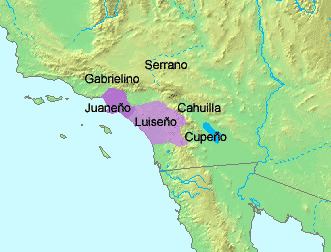Native to United States Native speakers 5 (2007) | Dialects LuiseñoJuaneño | |
 | ||
Ethnicity 2,500 Luiseño and Juaneño (2007) Language family Uto-AztecanNorthern Uto-AztecanTakicCupanLuiseño | ||
The Luiseño language is an Uto-Aztecan language of California spoken by the Luiseño, a Native American people who at the time of the first contacts with the Spanish in the 16th century inhabited the coastal area of southern California, ranging 50 miles (80 km) from the southern part of Los Angeles County, California, to the northern part of San Diego County, California, and inland 30 miles (48 km). The people are called "Luiseño" due to their proximity to the Mission San Luis Rey de Francia.
Contents
- Morphology
- Vowels
- Variants
- Vowel syncope
- Vowel length
- Accent
- Consonants
- Spelling systems
- Sample texts
- Linguistic documentation
- References
The language is highly endangered, but an active language revitalization project is underway, assisted by linguists from the University of California, Riverside. The Pechanga Indian Reservation offers classes for children, and in 2013, "the tribe .. began funding a graduate-level Cal State San Bernardino Luiseño class, one of the few for-credit university indigenous-language courses in the country."
As of 2012, a Luiseño video game for the Nintendo DS is being used to teach the language to young people.
The dialect spoken by the Juaneño people is extinct.
Morphology
Luiseño is an agglutinative language, where words use suffix complexes for a variety of purposes with several morphemes strung together.
Vowels
Luiseño has five vowel phonemes.
Variants
For some native speakers recorded in The Sparkman Grammar of Luiseño, the allophones [ə] and [ɨ] are free variants of [e] and [i] respectively. However, other speakers do not use these variants. Sparkman records fewer than 25 Luiseño words with either [ə] or [ɨ]. For one of these words (ixíla “a cough”) the pronunciations [əxɨla] and [ɨxɨla] are both recorded.
Unstressed [u] freely varies with [o]. Likewise, unstressed [i] and [e] are free variants.
Vowel syncope
Vowels are often syncopated when attaching certain affixes, notably the possessive prefixes no- “my”, cham- “our”, etc. Hence polóv “good”, but o-plovi “your goodness”; kichum “houses” (nominative case), but kichmi “houses” (accusative case).
Vowel length
Luiseño distinguishes vowel length quantitatively. Luiseño vowels have three lengths.
Overlong vowels are rare in Luiseño, typically reserved for absolutes, such as interjections, e.g. aaashisha, roughly “haha!” (more accurately an exclamation of praise, joy or laughter).
Accent
A stress accent regularly falls on the first syllable of a word. In Luiseño, stress is fixed and is not contrastive.
Many orthographies mark irregular stress with an acute accent on the stressed syllable’s vowel, e.g. chilúy “speak Spanish”. In these systems, irregularly stressed long vowels either carry a written accent on both vowels or the first vowel only, e.g. koyóówut or koyóowut “whale”. Also, stress is not visually represented when it falls on the first syllable, e.g. hiicha “what”.
Another convention is to mark stress by underlining accented vowels, e.g. koyoowut “whale”.
As a rule, the possessive prefixes are unstressed. The accent remains on the first syllable of the root word, e.g. nokaamay “my son” and never *nokaamay. One rare exception is the word pó-ha “alone” (< po- “his/her/its” + ha “self”), whose invariable prefix and fixed accent suggests that it is now considered a single lexical item (compare noha “myself”, poha “him/herself”, etc.).
Consonants
Luiseño has a fairly rich consonant inventory.
Spelling systems
Along with an extensive oral tradition, Luiseño has a written tradition that stretches back to the Spanish settlement of San Diego. Pablo Tac (1822–1841), a native Luiseño speaker and a convert to Roman Catholicism, was the first to develop an orthography for his native language. His orthography leaned heavily on Spanish, which he learned in his youth.
Although Luiseño has no standard orthography, a commonly accepted spelling is implemented in reservation classrooms and college campuses in San Diego where the language is taught. The various orthographies that have been used for writing the language show influences from Spanish, English and the IPA.
Sample texts
The Lord's Prayer (or the Our Father) in Luiseño, as recorded in The Sparkman Grammar of Luiseño:
Cham-na’ tuupaña aaukat cham-cha oi ohó’vanma.Toshño om chaami.Loví’i om hish mimchapun ivá’ ooxñ tuupaña axáninuk.Ovi om chaamik cham-naachaxoni choun teméti.Maaxaxan-up om chaamik hish aláxwichi chaam-lo’xai ivianáninuk chaam-cha maaxaxma pomóomi chaami hish pom-lo’xai aláxwichi.Tuusho kamíí’i chaami chaam-lo’xai hish hichakati.Kwavcho om chaami.Our-father / sky-in / being / we / you / believe / always.Command / you / us.Do / you / anything / whatever / here / earth-on / sky-in / as.Give / you / us-to / our-food / every / day.Pardon / you / us-to / anything / bad / our-doing / this as /we / pardon / them / us / anything / their-doing / bad.Not / allow / us / our-doing / anything / wicked.Care / you / us.Linguistic documentation
Linguist John Peabody Harrington made a series of recordings of speakers of Luiseño in the 1930s. Those recordings, made on aluminum disks, were deposited in the United States National Archives. They have since been digitized and made available over the internet by the Smithsonian Institution.
